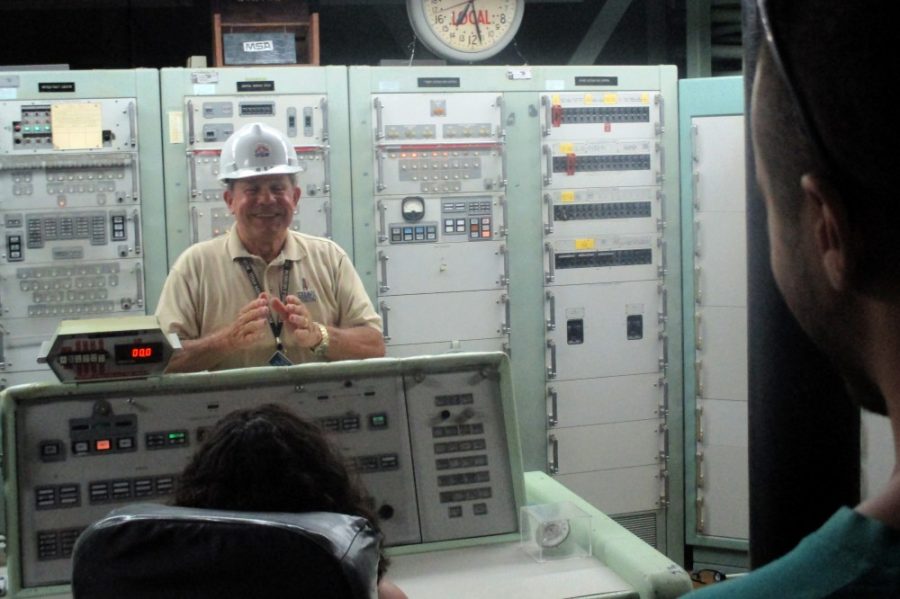The unassuming desert hills did not distract me as I thought about the hallowed ground on which I stood. Just 35 feet below me rested the secret control center of one of the world’s most powerful weapons: the Titan II nuclear missile.
18 silos were built around the Tucson area during the height of the Cold War, but only one remains in the form of the Titan Missile Museum.
The outside of the museum is rather inconspicuous. An array of antennas guards the small metallic visitor’s center and a fence separates the main road from the silo. In the visitor’s center, you check out artifacts from the early atomic age and purchase tickets for the hourly guided tour. A map showing the potential destruction zone caused by a nuclear missile hitting the Tucson area is an eerie reminder that history would be very different with the turn of a few keys.
“In nuclear war there are no winners,” said Hayward Sumner, a former crew commander at a Wichita, Kan., Titan II Silo and a volunteer tour guide at the museum. “[There are] only differing levels of destruction.”
After donning a hard hat, I descend 55 steps into a subterranean Cold War relic. Like their mythological namesake, the Titan’s two blast doors were incredibly large and designed to withstand a nuclear blast. Through the doors is the sterile, fluorescent hallway that led to the control center. An aging command console is positioned at the center of the circular room. Dim yellow lights emanate from the computers, informing workers of the facility’s status and the health of the missile.
Shortly after arriving in the control center, we are assigned crew positions and begin a simulated Titan II launch.
“Charlie, Oscar, Papa, Yankee, Delta, Echo, Sierra, Kilo,” the speaker whines as we receive a message from Strategic Air Command.
The crew opens the bright red safe and verifies that the orders are from the commander-in-chief. One of the three preset locations, which are still classified today, is loaded into the missiles’ guidance system, and the keys are readied for launch. The tension rises in the room as our crew commander and deputy crew commander each turn and hold their keys. Only five seconds until we put millions of people in premature graves.
Click.
Indicator lights flash on. The missile has begun its automated launch sequence. Water fills the silo.
“Total time from key turn to liftoff is 58 seconds,” Sumner said.
The missile launches from the silo. 30 minutes from target. And then, silence.
We wait for orders from some occult hand that survived the ramifications of our actions. According to Sumner, the crew has 30 days of food and water but only 12 to 16 days of breathable air. If we don’t hear anything, then it’s up to the crew commander to decide when to open the blast doors to face whatever is left of civilization.
After the simulation, little traces of humanity seem to be everywhere in this top-secret bunker. Signs litter the facility informing crew members to travel in pairs for the sake of safety. The sea foam green paint that drapes the entire complex seems too cheery of a color for the home of a nine-megaton nuclear bomb.
Following the launch, we enter another eerie tunnel to the silo. Large plexiglass windows give us a view of the almost 100-foot-tall missile and the open hatch doors above us let in the comforts of natural light. After returning to the surface, we get our first views of the steel and concrete hatch that hid the missile from view.
When President Ronald Reagan decommissioned the Titan II program in 1981, Titan II silos were destroyed in Wichita, Kan., Little Rock, Ark., and Tucson. This particular silo was converted into a museum in 1986. As part of our treaty with the Soviet Union, the hatch doors and other parts of the silo were made inoperable. Russia still retains inspection rights to ensure that it is not an active weapons facility and inspectors last visited in 2011.
After touring the surface, you exit the museum through the gift shop. Here you purchase genuine pieces of Cold War history, like “civil defense yellow” survey meters, emergency drinking water and scrap from the decommissioned missile. It feels odd looking at parts of a nuclear weapon being sold in a backwoods gift shop, but maybe it’s a reminder to never let tensions get this high again.
The Titan Missile Muesum is a humbling experience located half an hour way from the UA campus in Sahuarita, Ariz. It offers riveting and fun tours every hour from 9 a.m.–4 p.m. Admission to this must-see experience is $9.50 for adults and worth every penny. More information can be found on its website at titanmissilemuseum.org.
_______________
Follow Patrick O’Connor on Twitter @tachyzoite









